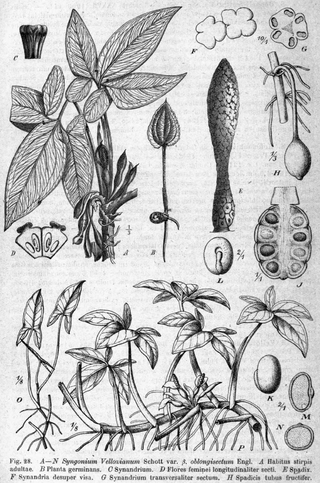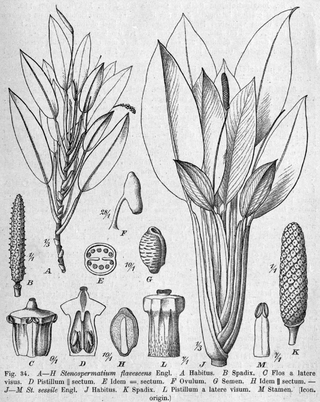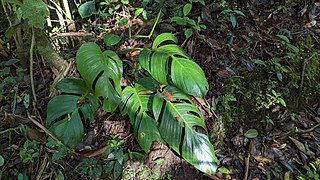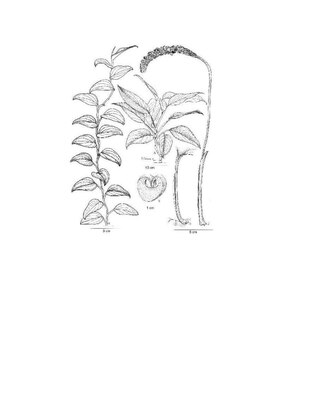
The Araceae are a family of monocotyledonous flowering plants in which flowers are borne on a type of inflorescence called a spadix. The spadix is usually accompanied by, and sometimes partially enclosed in, a spathe. Also known as the arum family, members are often colloquially known as aroids. This family of 140 genera and about 4,075 known species is most diverse in the New World tropics, although also distributed in the Old World tropics and northern temperate regions.

Dieffenbachia, commonly known as dumb caneorleopard lily, is a genus of tropical flowering plants in the family Araceae. It is native to the New World Tropics from Mexico and the West Indies south to Argentina. Some species are widely cultivated as ornamental plants, especially as houseplants, and have become naturalized on a few tropical islands.

Syngonium is a genus of flowering plants in the family Araceae, native to tropical rainforests in southern Mexico, the West Indies, Central and South America. They are woody vines growing to heights of 10–20 m or more in trees. They have leaves that change shape according to the plant's stage of growth, and adult leaf forms are often much more lobed than the juvenile forms usually seen on small house plants. The scientific name of the genus comes from the Greek words σύν and γονή and refers to the fused ovaries of female flowers.

Philodendron is a large genus of flowering plants in the family Araceae. As of September 2015, the World Checklist of Selected Plant Families accepted 489 species; other sources accept different numbers. Regardless of number of species, the genus is the second-largest member of the family Araceae, after genus Anthurium. Taxonomically, the genus Philodendron is still poorly known, with many undescribed species. Many are grown as ornamental and indoor plants. The name derives from the Greek words philo- 'love, affection' and dendron 'tree'. The generic name, Philodendron, is often used as the English name.

Monstera deliciosa, the Swiss cheese plant or split-leaf philodendron is a species of flowering plant native to tropical forests of southern Mexico, south to Panama. It has been introduced to many tropical areas, and has become a mildly invasive species in Hawaii, Seychelles, Ascension Island and the Society Islands. It is very widely grown in temperate zones as a houseplant.

Xanthosoma is a genus of flowering plants in the arum family, Araceae. The genus is native to tropical America but widely cultivated and naturalized in other tropical regions. Several are grown for their starchy corms, an important food staple of tropical regions, known variously as malanga, otoy, otoe, cocoyam, tannia, tannier, yautía, macabo, ocumo, macal, taioba, dasheen, quequisque, ʻape and as Singapore taro. Many other species, including especially Xanthosoma roseum, are used as ornamental plants; in popular horticultural literature these species may be known as ‘ape due to resemblance to the true Polynesian ʻape, Alocasia macrorrhizos, or as elephant ear from visual resemblance of the leaf to an elephant's ear. Sometimes the latter name is also applied to members in the closely related genera Caladium, Colocasia (taro), and Alocasia.

Rhaphidophora is a genus in the family Araceae, occurring from tropical Africa eastwards through Malesia and Australasia to the Western Pacific. The genus consists of approximately 100 species.

Rhodospatha is a genus of plant in family Araceae. It is native to South America, Central America, and southern Mexico.

Stenospermation is a genus of plant in family Araceae native to South America and Central America.

Epipremnum is a genus of flowering plants in the family Araceae, found in tropical forests from China, the Himalayas, and Southeast Asia to Australia the western Pacific. They are evergreen perennial vines climbing with the aid of aerial roots. They may be confused with other Monstereae such as Rhaphidophora, Scindapsus and Amydrium.

Monstera adansonii, the Adanson's monstera, Swiss cheese plant, or five holes plant, is a species of flowering plant from family Araceae which is widespread across much of South America and Central America. Monstera adansonii is classified as a hemi-epiphyte vine and can be found in tropical forest with hot and high humidity conditions. Other regions this plant may be found in are the West Indies, Antigua, Grenada, Saba, St. Kitts, Guadeloupe, Marie Galante, Dominica, Martinique, St. Lucia, St. Vincent, Tobago, and Trinidad. Currently, there are three recognized subspecies of Monstera adansonii, the M. adansonii subsp. blanchetii, M. adansonii subsp. klotzschiana and M. praetermissa.species. A fourth subspecies has been proposed recently, the M. adansonii subsp. laniatais, distinguishable by the number of leaf fenestrations and the angle of the fenestrations. The species are quite common near river valleys at lower elevations.
Monstera tacanaensis is a species of flowering plant in the genus Monstera of the arum family, Araceae.
Monstera juliusii is a flowering plant in the family Araceae. It is native to high-altitude cloud forests of Costa Rica at altitudes of 1,600 to 2,250 metres and occasionally confused with Monstera standleyana. However, M. standleyana has green petioles, few fenestrations and thin leaves, while M. juliusii is characterized by mottled white petioles, frequent fenestrations at maturity and thick, leathery leaves. Mature plants have pinnatilobed leaves as long as 60 cm and 30 cm wide, with circular fenestrations close to the margins, and oval fenestrations near the midrib. The species is named after Julius Johnson, son of the artists Rashid Johnson and Sheree Hovsepian.

Monstera monteverdensis is a species of flowering plant in the arum family, Araceae. Its adult form is characterized by pinnatifid margins with up to eight lobes per side, with occasional fenestrations away from the midrib. Leaves can grow as large as 60 cm long and 30 cm wide. It is named after the city of Monteverde, where the species is abundant.

Monstera tuberculata, also called the giant Monstera or the giant velvet-leaf Monstera, is a species of plant in the genus Monstera native from Mexico south to Panama. It grows in lowland wet tropical biomes up to 200 metres (660 ft) in elevation. Similar to Monstera dubia and a few other species in its genus, when young M. tuberculata has a shingle-like growth habit with leaves tightly pressed against the trunks of trees. As it matures, it has short-stemmed, oval leaves that lack the fenestrations of better-known species like Monstera deliciosa. Unusually for an aroid, its fruit hangs like a pendant.

Monstera gambensis is a species of plant in the family Araceae. It is endemic to the tropical forest of La Gamba, Golfito, Costa Rica at 100m elevation. They can be found on the floor of humid forests with their stems climbing up trees and aerial roots visible above the soil. Sometimes the entire plant can be found solely on trees. M. gambensis is typically not fenestrated until the adult stage, but can have two perforations on their blade.

Philodendron opacum is a species of flowering plant. It has a native range extending from Southeast Nicaragua to Ecuador and includes Colombia, Costa Rica, Ecuador, Nicaragua, Panama. Its habitat is largely restricted to the Tropical Wet Forest and Premontane Wet Forest life zones in Central America, but in South America extends into Premontane Rain Forest (Colombia) and Tropical Moist Forest (Ecuador).




















